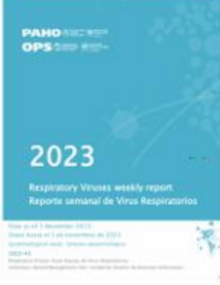
|
North America: Influenza activity has remained at low levels, albeit with a slight increase. Over the last four epidemiological weeks (EWs), the predominant influenza viruses have been influenza A(H1N1)pdm09, with concurrent circulation of influenza B/Victoria and, to a lesser extent, influenza A(H3N2). The activity of respiratory syncytial virus (RSV) has shown an increase, although it remains at low levels. SARS-CoV-2 activity continues at moderate levels, with a slight decrease. Cases of influenza-like illness (ILI) have remained low, while cases of severe acute respiratory infection (SARI) have shown an increase, with both showing an increase associated with positive influenza cases in the last four EWs. In Canada, SARS-CoV-2 activity remains high but is declining, with a slight increase in RSV activity. In Mexico, influenza circulation has remained at epidemic levels, and SARI activity has increased in association with a rise in the percentage of positive cases for influenza. In the United States, there has been a slight increase in influenza activity, although it remains below the epidemic threshold. Caribbean: Influenza activity has shown fluctuating increases in the last four EWs, reaching moderate levels. During this period, the predominant viruses have been influenza A(H1N1)pdm09, followed by influenza A(H3N2) and influenza B/Victoria. RSV activity has also increased to moderate levels. SARS-CoV-2 activity, although with a slight decrease in the last EW, remains at moderate levels. Cases of ILI and SARI have remained stable in the last three EWs. Belize has experienced a significant increase in influenza activity in the last four EWs. The Dominican Republic has seen a pronounced increase in RSV activity in the last four EWs, with epidemic levels of SARI activity that have decreased in the last EW. Haiti continues to experience epidemic levels of SARI in the last four EWs, with the majority of cases testing positive for SARS-CoV-2 and, to a lesser extent, influenza. In Jamaica, SARS-CoV-2 activity remains at moderate levels, albeit with a decline, while RSV and influenza have shown a pronounced increase in positivity rates in the last EW, resulting in pneumonia levels at the threshold of moderate activity. Saint Lucia continues to have elevated levels of SARS-CoV-2 activity and an increase in RSV and influenza activity, with SARI activity above the threshold of high activity. In Barbados, influenza activity remains at intermediate levels, and SARS-CoV-2 activity, along with RSV, continues to decline. Central America: Influenza activity has remained stable at low levels of circulation in the last four EWs. During this period, the predominant influenza viruses have been influenza B/Victoria, with concurrent circulation of influenza A, mainly A(H1N1)pdm09, followed by influenza A(H3N2). RSV activity has remained elevated in the last four EWs, with a slight decrease in the last three. SARSCoV- 2 activity is at low levels. The number of newly detected cases of ILI and SARI has remained low; however, the proportion of SARI cases attributable to RSV has remained high in the last four EWs, with a pronounced increase in the last one. In El Salvador, RSV activity remains high, SARS-CoV-2 activity has remained low in the last four EWs, and influenza activity has remained at epidemic levels during the last EW, with epidemic levels of SARI. In Guatemala, RSV activity, while remaining high, continues to decline in the last four EWs, and cases of SARI, mostly positive for RSV, have also decreased. In Honduras, RSV activity has remained at moderate levels with an increase in the last EW, with the majority of SARI cases being positive for RSV. In Nicaragua, influenza activity remains stable at epidemic levels. In Panama, RSV activity continues at high levels of circulation. Andean Region: Influenza activity remains stable at low levels of circulation. Over the last four EWs, the predominant influenza viruses have been influenza B/Victoria, followed by influenza A, mostly A(H1N1)pdm09. RSV activity remains fluctuating at low levels. SARSCoV- 2 remains at moderate levels of activity. ILI and SARI activity in the subregion continues at low levels. In Bolivia, the circulation of SARS-CoV-2 remains high. In Ecuador, SARS-CoV-2 is declining, while influenza activity has risen to epidemic levels in the last three EWs. In Colombia, SARS-CoV-2 and RSV activity remain at low levels, with a decreasing trend. In Peru, SARS-CoV-2 activity remains low and is declining in the last two EWs. In Venezuela, there have been epidemic levels of influenza activity with a decline in the last two EWs. Brazil and Southern Cone: Influenza activity remains at low levels of circulation. Over the last four EWs, the predominant influenza viruses have been mainly influenza B/Victoria, with simultaneous circulation of influenza A(H1N1)pdm09. RSV activity remains at low levels. SARS-CoV-2 activity is on the rise, with intermediate levels of circulation. Both ILI and SARI activity have remained low in the last four EWs, with the majority of positive cases attributable to SARS-CoV-2. Argentina has presented moderate and declining SARS-CoV-2 activity during the last four EWs, and influenza activity has shown a slight increase, with ILI and SARI levels below the epidemic threshold. In Brazil, SARS-CoV-2 activity continues to rise, reaching high levels. In Chile, there is a pronounced increase in SARS-CoV-2 activity, with very high levels of circulation, and an increase in influenza activity above the epidemic threshold, resulting in moderate ILI levels and epidemic levels of SARI. In Paraguay, SARS-CoV-2 circulation, although low, has shown a slight increase in the last two EWs, and SARI activity is at moderate levels in the last EW, with the majority of positive cases attributable to SARS-CoV-2. In Uruguay, SARI activity remains on the decline in the last four EWs, with epidemic levels, most cases associated with SARS-CoV-2, and an increase in the percentage of positive cases in the last two EWs. |

